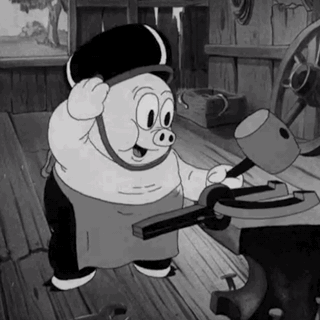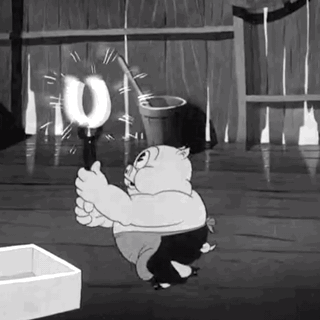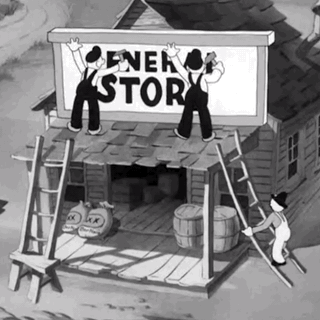Release date: December 5th, 1936
Series: Looney Tunes
Director: Tex Avery
Starring: Earle Hodgins (Narrator), Tex Avery (Blacksmith), Joe Dougherty (Porky)
A few reviews ago, I said that Porky in the North Woods was the first cartoon to debut the “Porky Signature” opening. Turns out I was wrong, it’s actually THIS one! (a small error, though, considering Porky in the North Woods is the cartoon right after this one. Still, my mistake!) A witty retelling of the longsfellow poem that pins Porky as a clumsy smithy, which results in trouble.
Earle Hodgins does a wonderful job as the narrator. We open to him literally setting up the scene—after he says “Under the spreading chestnut tree”, a chestnut tree falls to the ground, the “standing” village smithy not far behind, lazing on the grass and most certainly NOT standing. The narrator sighs. “I said STAND. Stand up, you lug!”
The smithy does so, his back to the audience. “Hey, this way!” He whips around to ogle at the audience before swaying bashfully. While lauding the smithy’s physique, comedy’s greatest friend, juxtaposition, strikes hard. Instead of seeing the smithy’s brawny arms, we’re met with twigs, hilariously accompanied by his overly large, sinewy hands. Recognizing the folly, the smithy takes a moment to inflate his muscles by blowing into his respective thumbs.
“...and now, the blacksmith shop.” The smithy throws up his dukes and boxes at an unseen foe as the shack falls into place right behind him. Contented with his new shop, the smithy goes inside to investigate, while the local schoolchildren come to observe the smithy at work. “They love to see the flaming forge and hear the bellows roar.” A wonderful closeup as the bellows lets out a ferocious lion’s roar, the narrator remarking “Boy, what a roar!”
One of my favorite gags in the entire cartoon is when the children are observing the smithy. The narrator suddenly grows hotheaded, shooing them out. “Alright kids, get out of the scene now! You bother me.” Even better is the reaction from the kids, all grumbling and trudging away, one even kicking a van across the screen in defiance. Hodgins’ voice combined with Tex’s timing make for a wonderful end product of comedy.
With the smithy now alone, he pumps the bellows up and down and up and down and up and down up and down up and down up and down—the narrator repeats “up and down” at a furious pace, the smithy struggling to keep up, pumping frantically with his giant tongue hanging out of his mouth in exhaustion. Another wonderful gag that is succinctly timed. Even better is the dialogue spawned from the gag: fed up with his mistreatment, the smithy tosses away the bellows and directly addresses the narrator. “Listen, chief! Take it easy. We got plenty of time, this cartoon ain't half over yet!” Tex Avery provides the voice of the smithy, and I believe this is Virgil Ross animation.
So, with that reassurance that we have plenty of time, the narrator introduces our hero, Porky Pig. Great juxtaposition with the triumphant fanfare and then the pan over to reveal tiny, portly Porky shaking his fists in the glory. The narrator takes a moment to recollect himself. “Let’s see, we have the blacksmith—“ the smithy sticks his tongue out at the narrator “—the blacksmith shop... now, boys, we need a horse.”
Bob Clampett animates the scene of the smithy and Porky looking for the horse, Porky hilariously lifting up a magazine and a barrel on the ground, as if a giant horse would be hiding under such menial and small objects. The fated horseshoe clops grow louder, and a camel struts into view. “Oh, my mistake. This little fellow belongs in our foreign feature picture.” A cane drags the camel offscreen, and the void is soon replaced by a white horse, thrown onto the scene.
The smithy pulls the horse out of his reins and leads him to a barrel, where the horse sits down like a human. Measuring the horse’s hoof, the smithy declares “Size 6 and 7/8ths!”, a number that would be frequented in quite a few cartoons. Porky dutifully salutes and scours the shop for a suitable horseshoe, stacked in shoeboxes in neat rows of shelves. Another director attempting to pull off such a literal gag may have gotten a few polite chuckles, but Tex ensures that it’s funny. It’s not that wild of a gag if you think about it, but Tex approaches it like it is. His love of jokes and gags really breathe life into his cartoons.
Absentmindedly, Porky reaches into a box of rubber horseshoes instead of iron horseshoes (cleverly named Bad-Year, a take on the Goodyear tires.) Rubber horseshoes were all the rage in the ‘30s, presumably because they were much quieter than iron and much more comfortable for the horse. Unfortunately, being rubber, they aren’t so easy to smelt. Lots of bounce-back.
Porky finds this out fairly quickly as he goes to hammer the horseshoe, then getting whacked in the eye by the hammer and glaring at the horseshoe suspiciously. Very funny animation by Bob Clampett. Porky tries again, getting hit once more. Instead, he ducks out of the way, so the hammer can’t hit him. Of course it does, konking him on the head. Ah, but wait! The perfect solution! Porky places a nearby kettle on his head like a helmet, and braces for impact as he pounds on the horseshoe. Nothing. Now complacent, Porky takes off his “helmet”, and the hammer wastes no time whacking him in the face, completely unprompted. Porky’s befuddled stare is lovely after the fact.
Horseshoe in hand, Porky goes to hammer the horseshoe to the horse’s hoof, but accidentally nails it to the smithy’s outstretched foot instead. Porky gives him the okay (a high pitched “Okey dokey” reused from Little Beau Porky), but quickly comes to realize his mistake.
The animation is quite literally bouncy, rubbery, and amusing as the smithy walks through his shop, practically skipping as the rubber propels him into the air with each step. His footsteps grow higher in height, to the point where the smithy bangs his head against the ceiling. Aggravated, he pries off the horseshoe, throwing it out of the shop in frustration. It bounces against a tree, and, being rubber, knocks right back into the smithy like a boomerang. This time, the smithy tosses the shoe out and slams the door shut, thinking he’s outwitted the horseshoe. Not the case—the horseshoe flies in from behind courtesy of an open window and hits the smithy, a gag that would be reused in Porky’s Badtime Story and later Tick Tock Tuckered.
Instead of letting his temper get to him, the smithy gingerly places the horseshoe on the ground with the utmost patience and grace. Of course, the horseshoe comes back with a vengeance, slingshotting into the face of the smithy from just the slightest contact with the floor. A lovely gag with perfect timing.
Now visibly furious, the smithy places the horseshoe in a clamp, locking it so as to keep it still. Locked in place, the horseshoe causes the entire shop to tremble vigorously as it tries to break out of its vice. The smithy puts the shoe out of its misery by shooting it with a gun, the shoe flopping down motionless. In all, a great sequence that really takes advantage of rubbery animation. Not unlike Porky’s dog drinking rubberizing solution and literally turning into a rubber hose character in Porky’s Tire Trouble.
A befuddled Porky wanders into the scene, bringing the smithy his trusty steed. The smithy orders Porky to get him a (proper) horseshoe. The smithy literally smacks the horse into its reins, pushing its entire body through the exposed hole, while Porky prepares the horseshoe, smelting it.
In many of my Tex reviews, I often laud him about his use of timing and speed. A few times i’ve mentioned how the timing has thrown an entire cartoon out of proportion. This is always the scene I have in mind. Porky grabs the smoldering hot horseshoe, running across the shop with the searing death trap unsecured in a clamp. Porky trips, and the horseshoe is sent flying into the air, landing right on the horse’s butt and essentially branding it. The horse justifiably leaps up in agony, and with the cart attached, barrels into the smithy. Thus, the smithy is sent toppling into the wagon, pulled uncontrollably by a burning horse.
Just a great number of gags, one after the other. The chase leads out of the shop and right through a general store, reducing it to nothing but wood planks and half a foundation. Past the traffic guard they zoom, spinning the guard around like a top in the process. Whirling past a bank destroys the façade, and the interior is exposed as we spot a robber trying to hammer his way into the safe. A ditch digger ducks just in time for the horse and the smithy to race by, the digger popping his head up from the hole and ogling at the audience nonplussed.
A sign reads HERE THEY COME!, and certainly they do come, spinning the sign in the process so that the other side reads THERE THEY GO! The horse manages to flip the cart and itself over a chasm, maintaining no breaks in the chase. Just a great setup as the sequence freezes for a moment, the smithy addressing the audience, “Whew! What a buggy ride!”
The chase is led to a fence, the pulled string slingshotting them BACKWARDS. As expected (yet still exhilaratingly so), the entire chase scene plays out backwards—a classic Averyism. This entire chase scene is highly reminiscent of a chase scene in Tex’s first Droopy cartoon, Dumb-Hounded, though to a higher degree. Same exhilarating chase, same exhilaration reversed. Here, the damage is essentially reversed—the sign is flipped back to HERE THEY COME!, the ditch digger almost gets his head cut off once more (though this time he asks “Say, am I missing something?”), the bank façade is restored and the robber concealed, the traffic guard is put out of his interminable top spin, A newly constructed general store with workers putting on the finishing touches is moved out of the way just in time for the horse and the smithy to not so safely return to the shop.
Winded, the smithy wipes the sweat off his forehead. “Say, listen,” he addresses Porky, “tell me how all this happened.” Porky re-enacts the scene. “Well, I just had a hot horseshoe like this—“ he holds up another scalding hot horseshoe, “—and I was running like this, and uh...”
As he runs with the horseshoe, he trips over once more, and the horseshoe is sent flying into the horse’s rear a second time. We iris out as the entire chase scene starts from the beginning, the smithy sent toppling into the cart and barreling into the general store.
So much to address! But, in all: this is one of my favorite Tex cartoons at his tenure at Warner Bros. Earle Hodgins does a fantastic job as the narrator, Tex as the smithy. The cartoon is so anti-Disney, so sardonic, so wild and out there, so unconventional. It’s still hilarious (and then some) 84+ years later, and still innovative and new.
The fourth wall breaks are strong and feel natural, not at all forced or obligatory. The animation is fun and amusing, especially in conjunction with the increasingly frustrated narrator. And that chase scene is just impeccable. Truly a scene that just goes off the rails. Remember, all of that destruction and havoc occurred because Porky TRIPPED and a horseshoe burnt the horse. 10 seconds in and the chase wasn’t even about the burn anymore, it was just a chase for the hell of it. And it totally works. I definitely encourage you to see the scene, if not this entire cartoon in general. I can’t implore you enough to watch it. I truly think this is one of the best cartoons we’ve seen in this journey. See for yourself and allow the cartoon to succeed in where my words have failed.
Link!














No comments:
Post a Comment